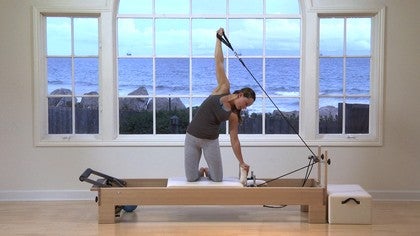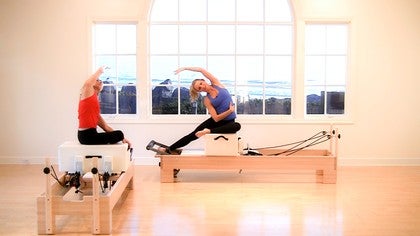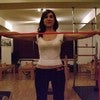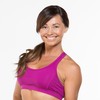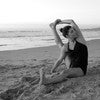Description
About This Video
Transcript
Read Full Transcript
Hi, I'm Courtney Miller and today I'll be taking you through a 45 minute workout that will really challenge your muscles. This is more of an athletic conditioning approach to Pilates, we'll be using the reformer and the ball. I've got the reformer set up already with three red springs on, and the bar in mid position. Headrest is in the up position. Taking a seat and then lying onto the back, I'll begin with my toes onto the foot bar, the ball between my inner thighs, not right up at the knees, so my feet are hip distance apart, and already I have to begin working my aductors to hug my femurs in towards my midline.
Pelvis is in neutral, breath in to prepare, exhale as I press all the way out, really focusing on pressing down through the big toe mound of my foot. Inhale as I come in. I'll press out about 10 times here. My focus is on maintaining that parallel shape with my femurs. The ball is not a circle, the ball is an oval, because I'm squeezing it so much.
As I feel my aductors squeeze in towards my midline it better enables me to get into my deep abdominal muscles, so as I press out and I feel that length through my thighs I'm also feeling the lift up through my pelvic floor. That's about 10 there, I'll come halfway in, keep the squeeze in the ball, small presses out and in. Breath is a little bit more natural here, but I am emphasizing that exhalation to draw my ribs down and my deep abdominal muscles in. How about four more, and three, heels are nice and high, two, and on one I'll keep the carriage halfway out and just squeeze in and in. Already my thighs are burning, I'm deepening that inner thigh connection.
Make sure that my tailbone and seat feel heavy and I'm not coming into a posterior tilt here, I'm really emphasizing that neutral. Final three, two, and one, pressing all the way out going to that length and lowering the heels under the bar, 10 calf raises here, exhale and inhale to lift. I'm still hugging in, I still feel my inner thighs, it's not a break for those muscles, but I am really enjoying the length through the front of my body. Chin is away from the chest, neck is long, spine is long and neutral, and last time here, bending and coming halfway in, again, just holding, keeping that squeeze. Without moving the carriage I'll lower the heels down and lift them up on my exhale, so it's an inhale to lower, exhale to lift.
Every time I lift my heels up, I'm encouraging my pelvic floor to come up and in, my navel to draw down, so it's already a full body workout, inner thighs are protesting a little bit, and a lift. It's quite challenging to keep the legs moving at the same tempo. I can feel sort of that one heel wants to lift and dominate before the other one. Keeping the heels up, squeeze an inch, I'll go all the way up for the length, and then bend my knees to come in. Changing so the heels of the feet are onto the bar, so slightly different muscle emphasis.
Again, pressing through the big toe mound is important here, keeping my feet level, I'm trying to avoid that cycling nature. Inhaling to prepare, tailbone neutral, exhale to press out. Inhale in, exhale to press out, and inhale. The other great thing about using the ball, aside from it making the whole series a little bit more challenging, is I can feel if I'm pressing more through one leg. I can actually see it as an instructor when I'm training my clients, the ball will shift side to side if they don't push evenly through each leg, so it really gives you that tactile tool to feel if you're balanced or not as you press out.
Lifting out through the seat, I've got my heels on, so emphasis is a little bit more in the hamstrings. Be careful of the muscles in the front of the shins dominating here, so the feet are staying in a neutral position, and I'll come halfway in and I'll repeat my small presses out an inch and in. Press and in, press, relax through the toes a little, remember this movement originates as close to the center of your body as possible. We'll do four more. And three, notice if you're gripping in your shins relax a little, two, and one, holding and just squeezing in, and in, and in, and these holds are so challenging.
We'll do four more. Three, tailbone heavy, two, and one, press all the way out, and then bending the knees and coming all the way in for a break, rocking the knees from side to side, releasing any tension from the hips. Coming up and making a quick change. So I'm going to have one red and one blue on for my spring tension here, I'll move the foot bar down as well to flat position. Lying on my back.
From here I'm gonna be placing the ball underneath my tailbone, so I lift my hips up, roll it under. I make sure that the ball is indeed underneath my sacrum and not underneath my low back, the idea here is not to use the prop to force you into an anterior tilt, but instead stay in a neutral position, you're just lifted. Reach back, grab the straps, and then once I've found my abdominal connection with a strong exhalation I can draw my legs into a table top position. I already feel a little balance challenged. On an exhale, I'll draw my arms all the way down, pause for a moment, make sure I'm reaching energy through my fingertips, collar bones are wide, inhale, arms reach up with resistance.
Exhale down and inhale up. So while I have the ball underneath my sacrum, I'm not gonna be lifting my head, neck, and shoulders up, so I'm just allowing my upper body to rest down as I hug my inner thighs towards the midline. We'll do three more here, really resisting on the lift, drawing the scapula down the back. Two, and last time, one, adding some leg movement, I exhale, extend arms and legs together, inhale, bend it in. So while the ball is underneath my sacrum I'm able to go a little bit lower in my leg extension than I would be able to without the ball.
I can feel my lower abs are challenged in this position, and I'm taking care not to allow my spine to overextend. Lots of obliques. Last time like this, and from here I'll be leaving the legs long, so the longer the lever the more challenging the exercise. Arms and legs come up together, and arms and legs go down together. Inhale to lift, and exhale (breathes loudly) to lower.
So make this exercise your own, chose your range of motion. Remember, you're only lowering the legs as low as you can stay connected through your abdominal muscles. Three more like this, energy all the way out through the toes, inner thighs are strong, two, and last time. Let's add a little hold, ribs in, flex and point, flex and point, collar bones are wide, inner thighs connected, four more. Three, maybe you can lower your legs just a little, two, and hold one, bending the knees and releasing the arms up.
From here I'll take the elbows into the sides, collar bones are wide, exhale arms and legs extend, and inhale in, remembering that I have a sense of weight or heaviness in my sacrum. If my tailbone was a needle and the ball was a balloon I'd be pressing downwards as if I was trying to pop the balloon. Keep those arms hugging in towards your sides, the humerus stays still as we go through our tricep extensions. And last time like this. Adding single leg variation, one leg extends, and in, and other leg extends, and in.
So I can really feel the purpose of that ball now as I go into these single leg variations. My body wants to lean or tilt, and I have to anticipate that and stabilize prior to moving my legs, one more each side. Triceps are starting to feel warm. And release. From here I'll lower my feet, take both straps in one hand so I have a free hand, and with that free hand remove the ball.
It actually feels really nice to have the ball underneath the tailbone. Exhaling all of your air out and then drawing the legs in tabletop, you have two options here. If you choose to place the ball between the femurs you'll be keeping your legs in a tabletop position throughout the next series. Your other option is to take the ball between the ankles, in which case you can leave the tabletop or you can choose to go into the leg extensions. I'll take it between my ankles for today.
My arms are up, and now I've moved away from the shoulder blocks, so I no longer feel them. Nodding the chin towards the chest, exhaling to recruit those deep abdominal movers, and then lifting myself up, reaching through my fingers. I'll repeat the same series I did with the ball underneath my tailbone, but now that I'm in abdominal flexion, little different muscle emphasis, shoulders staying down the back and hugging the ball in towards the midline. Two more like this, resisting as the arms lift, and from here lift an inch and take the whole shape down. Adding the legs.
So nodding your chin, lifting up, arms lift up, arms and legs extend together, and then bend back in, arms and legs extending together. Feeling the abdominal muscles contract and compress in a downward fashion every time my legs extend. Remember to play with the range of motion here, little bit higher if you need to, or just leaving those legs in tabletop is absolutely fine. Let's hold the next one. Challenge by going a little bit lower, if that's available to you, and then taking the whole shape down.
Let's leave the head down, draw the arms in, up, and open, so just a quick little break for the abdominals, break for the neck flexors. Lifting and scooping. Last time here. Reversing our circles. So as I open my arms, my palms are in, when I lift the arms, the carriage does not move.
So I'm working mobility and stabilization in the same exercise. And that was our break. Bending the elbows in, nodding the chin, hundreds, exhale as you curl up, hug the ball, pump the arms, in through the nose, and out. (breathes loudly) In through the nose, eyeline right at the ball, and exhale. (breathes loudly) In through the nose, expanding through the back body, and exhaling. (breathes loudly) If you need to, bending the knees, being true and honest with your body, this is an abdominal series, not a hip flexor one, so if you need to, bring those legs in, and exhale to reach. Carriage is not moving, arms are long, shoulders down the back, two more sets, inhale, and exhale. (breathes loudly) Inhale, and exhale. (breathes loudly) Let's hold, lift an inch, and take the whole thing down. Rest the legs and hook up the straps, again, releasing any tension from your lower back, from your hips.
The ball can come out, and we can rise out. So from here, let's go ahead and place the ball down, focusing more on our upper body for the next series. I'm gonna change the springs so I only have one blue on, and we're actually gonna play with the springs a little bit for the series. The blue is the lighter tension, it'll be a little more abdominal focused. Our second set will be on a red spring, little heavier, little more shoulder focused.
The bar is still in the down position, and I come to a kneeling position on the reformer, knees hip distance apart. Coming onto my elbows and my forearms, it's important that I feel a sense of rooting or anchoring through my elbows, that's gonna connect me into my lats and into my obliques a little bit more. One foot goes back onto the foot bar, and before I begin the exercise, I find my position. Scooping my abdominals in and under, making sure my head is staying in line with the rest of my spine, taking the other leg back, heels are together, toes are apart, careful of dropping here, so really pull those abs up and in, eyeline at the headrest. Eight times I'll push, inhale, (breathes loudly) pull.
And (breathes loudly) pull. So I'm holding that plank position, I've got a little bit of life in my glutes and hip extensors, lots of sensation through my obliques, and pressing down through my elbows to get deeper into my lats. Two more. (breathes loudly) Last time. Little hold if you can, and finish by taking one knee down, and then the other. You can sit back into a child's pose, and if you felt that that exercise was challenging enough for you, leave the tension where it is.
Otherwise, switching to a single red will change the focus from mostly center to a lot of shoulders. Let's try it. Elbows are on, one foot comes on, I press all the way out. So I set myself up here, drawing my navel in, shoulders down, and then the leg comes back. Squeezing the heels together, inner thigh connection quite important in this position, eyeline down, pressing, and resisting in.
So remember here, we're not letting the springs do the work, keep that core working the whole time. Inhale forward, (breathes loudly) resist. (breathes loudly) So the challenge is much more in my delts now than my abdominals. Let's do three. And two.
And one, little hold if I can, taking one leg down and then the other. Again, nice little stretch after a plank always feels good. And lengthening out. Headrest goes down, I'll leave my one red spring on, extending my legs through the shoulder blocks making sure I have about a hand's worth of space behind me so that when I roll down I don't roll off, right into some biceps. So I start in my best neutral, abdominals in, I roll my pelvis away from my femur, getting into my C curve.
Once I'm here, deepening the C curve, chin stays level to the ground, and we bend, and reach. So I'd like you to think about the resisting out here and I want you to go to a long arm every time. So even in this approach, this more athletic conditioning type of approach, I still want the emphasis to be long, lean muscles, not shorter, bulkier, contracted. Reach all the way out and in. I want you to try to connect the movement in your elbow to your navel drawing in, so every time you flex the elbow see if you can flex the spine just a little bit more.
Last time. Release only halfway out, lower the elbows a few inches, lifting them. The carriage is not moving, my biceps and shoulders are burning, this isometric is quite challenging, and as I go through it I'm trying to deepen through my core. (breathes loudly) Two more here. And one.
Go back into the bicep position, nod my chin, using the abdominals to round forward and stretch. I'm gonna change the springs, bringing it down to a single blue spring from the red. You could do this next series on the red if you're feeling really strong today, otherwise you can do as I did and take it down a little bit. Working my posterior delts, start in your best neutral. Exhale, I roll my pelvis away from my femurs as I roll back, drawing my arms in towards me.
I'll open the arms to the side, rotate and tilt, eyeline down at my lower arms. From here my torso stays in position, and I exhale, just open the arms and then come back in. (breathes loudly) And back. So I feel a lot of obliques here, a lot of delts, and exhale, pull, (breathes loudly) and inhale. I'll do three more on this side, neck and shoulders down, legs hugging in towards the midline, two, and hold for one.
The carriage doesn't move as I go from center over to the other side. Repeating on this side, and open. Now that transition that I did from right side to left can be an exercise in of itself, and we'll do that to finish up. Make sure that you're pulling evenly with both arms here. Wrists stay long, shoulders down the back, last time, hold, carriage stays still as I come from center over to the other side.
Center, and open. Center, and reach. Last time. Lots of work in those delts, hold, and then with intention coming all the way forward, relaxing through the neck and shoulders, a few deep breaths here as I let my scapula drop down my back. Lengthening all the way up, head is the last thing to come up.
Using our box, placing it on long box position. I'm gonna leave the blue spring on for this next series, although it could be done with the red, depending, again, on how strong you're feeling. I definitely recommend sticking to the blue if you have difficulty maintaining a neutral or imprinted pelvis when you're loading the springs from the femurs. The legs go through the straps. So any lower back dysfunction, you know, maybe your obliques need a little extra strengthening, I definitely would stick to the blue for this series.
Alrighty, I move myself forward so that I've got room to lie backwards. Most likely your head is not gonna fit on, but you're in flexion anyways and you've got your hands free to support your neck. I'll lift my legs one at a time. So making sure that my tailbone is heavy, this is what I was talking about. So if you find you're having a difficult time keeping your ribcage connection, keeping that sense of neutral or working in an imprint, if that's ideal for you, you need to lighten the load.
Hands are behind the head, inhale, just the legs, exhale. (breathes loudly) Drawing them in. (breathes loudly) As my legs reach away from me, that's where I feel the most challenged to maintain my oblique connection, keeping the distance between my ribs and my hips closed and connected. I'm gonna add a little crunch to this, lifting higher as my knees come in. (breathes loudly) Legs are staying together here. Lift and lift. Last time. I'm gonna circle my arms around, support my legs, and allow my upper body to drop back, so just an opportunity for my neck to rest.
Nod your chin, roll back up, shoulders down, we're ready to continue, hands go behind the head, the legs go out, as I draw the legs in I rotate towards them, back through center. I can either stay on one side, or go into the reciprocal. (breathes loudly) Today we're doing one side, then the other. Pull from those low abdominals, and keep that stability, and pull. One more, each side, pull.
And pull, finding your center, going for that break, maybe it feels good to curl up, maybe it feels good to drop back. Nodding your chin, one more part to the series. Stay with me, we can do it. Legs in tabletop, hands to the knees, extending the arms and legs and circling as we scoop for a double leg stretch variation. Please play with your range of motion here, if you need to, the legs can stay in a higher diagonal.
If you need to, the legs can just stay in tabletop. (breathes loudly) Three more. (breathes loudly) Two. (breathes loudly) And one. (breathes loudly) And release, excellent. Nodding the chin and helping yourself come all the way back up to a seated position. Bringing our focus back to upper body. I'm gonna leave the blue spring on.
This exercise, again, could be done with the red, so play with it so that it works best for you at home. Grabbing ahold of the straps so that they're around my knuckles, I bring the box forward so that I'm not entangled into the straps, and thus it's much easier for me to come up and into a prone position. My chest is off the box so that I'm comfortable, my legs hip distance apart. Option to bend knees and cross ankles here to modify for any low back issues. I'll leave my legs extended, pubic bone down and heavy, taking my arms to goalie post position.
On an exhale, I'll reach my arms forward, inhale bringing them back to the goalie post. So abdominals really drawing up and in here, surprisingly I feel a lot of traps, mid traps, and rhomboids. You'd think that it would just be a delt primary focus, but I feel a lot of mid back stabilizers here as I hold my spine in this position. I'm trying to keep my hands higher than the box, and when I reach them forward no wider than the wooden rails. Three more here.
And two, like a torpedo, I'm really focusing on length, one, maybe I can hold, and let's finish by circling the arms around and releasing. Excellent. Taking a child's pose position, a few deep breaths, letting the back open up. So from here, I'll return the box in, hook my straps up, and I'll be placing the box back. All right, taking the bar into mid bar position and grabbing ahold of our prop again.
Coming into bridge work, make sure that the weight is appropriate for you. If you tend to cramp in your hamstrings easily you're gonna want a heavier tension, otherwise a red and a blue, you'll really feel those hamstrings working, two reds will be more supportive. Lying back again, coming away from the shoulder blocks, squeezing the ball between my femurs as it was when I started in my leg and foot work. Heels of the feet onto the bar, pressing evenly into the inside and outside part of your heels, hands are down. This is a great teaching tool for those clients who tend to let their legs just roll open and push their weight into the outside part of their heels.
Maybe it's weak inner thighs, maybe it's tight IT band, regardless, the ball between the inner thighs will instantly remedy that. On an exhale, I roll from neutral into an imprint and then up onto my shoulder blades. My ribs are closed and connected, I'm reminding myself this is not just a hamstring exercise but a glute one as well, so I feel my posterior tilt and glutes connected, hugging the ball in towards the midline, inhale, press back, allowing my pelvis to drop down, exhale, recruiting glutes to lift back up. So inhale as I press, and exhale (breathes loudly) to lift. Let's continue here.
So layering this information so that we can scan our body, making sure we're recruiting all the muscles we need to be, we're pressing down through the inside part of the heel, squeezing the inner thighs. My pelvis is in a posterior tilt, and I'm activating through my glutes. My abdominals are strong and connected, especially around my ribcage, pressing out and in. This movement is as much about going down and lifting up as it is pushing out and pulling in. One more.
Exhale to pull in. (breathes loudly) Let's hold and do a load transfer challenge. So consciously connecting through my right seat, extending my left leg and placing it down, and then connecting through my left seat, extending my right leg and place it down. One more each. Press, squeezing that ball, and last time, press, and take it down. Lift an inch, squeeze a little more, and then allow the spine to roll down with intention, one vertebra at a time, head is gonna be the very last thing to come up.
From here we get to lengthen those muscles. Take the ball between your inner thighs, give it a good squeeze, and circle the hands around. Extending the legs long and low, inhaling as you lift the legs up, exhaling as you roll onto your shoulder blades. Remember the headrest is down from our last exercise, so we absolutely wanna keep it down here as well. I'll squeeze the ball using my glutes and hamstrings, lifting the whole shape up, lowering the legs down, and releasing slowly, one vertebra at a time.
If you need a break, bend your knees in, otherwise keep the legs long. You can also do this exercise hands down, palms down if you feel like you're having trouble stabilizing as you hinge at the hips, lifting into your jackknife, and a lower, feel that stretch and a release, feels good on the spine. Two more, lift up, (breathes loudly) roll up, lengthen, and control, eccentric, work through those hip extensors, we can even flex our feet if we want to get a little more of a stretch. Last time, and I'm gonna do mine with my hands here. Roll up, (breathes loudly) elbows stay open, abdominals in, chin is away from the chest here, you see how I can clearly speak and it's because there's no weight on my cervical spine at all.
Legs go low, the lower the harder, why not add a little lift, maybe even a teaser, and release the whole thing down. Good job. Let's keep the ball, change the springs, one blue spring on, and go to a flat bar position. Coming to a standing position on the equipment, especially when there's one blue spring, be mindful that it's gonna move quite easily underneath you. We're gonna take our foot onto the gray platform first, and then our other foot onto the carriage.
Taking the ball between the heels of the hands and reaching the arms long, bending at the knees and coming into a deep plie or squat position. I'm in a slight posterior tilt here and I feel more weight through my heels than my toes. Fingers are reaching, and shoulders down the back. Pressing out through the carriage leg, and bringing it back in. As I press out, I'm emphasizing a downward energy through my baby toe.
I wanna keep the arches of my feet engaged. It's through those arches that I can activate through my inner thighs, and thus through my pelvic floor and really recruit that core stabilization system. Get down a little deeper if you can, and adding some rotation. So I'll rotate the ball to the leg that's pressing, and back and through. I really feel my right leg, the one that's stabilizing me, press.
You could do this on a heavier weight, a red spring, it would change the muscle emphasis, so play with it at home if you'd like to. One more here, and bringing it in, you're not done yet. Lower just a little bit, lift the arms overhead. Lower the arms, holding the legs in this position, a lift and a lower, lift, and lower, see if you can get down just a little more, weight into those heels, lower, hold, go down an inch, and then coming all the way up. Lots of burn.
I prefer that you step off of your equipment to turn around, so we come around the other side, standing onto the gray platform first, and then onto the carriage. Arms extend forward, set the shoulders down the back, and bend. So you can probably see better from this angle, I'm not allowing my chest to shift forward. I've got my tail scooped under a little bit, and most of my weight is through my heels. Once I've set that up, I can begin the movement.
On my stabilizing side, emphasis is in knee staying aligned over the mid foot. I've got the ball for a reason, so don't just hold onto it lightly, squeeze it between the heels of the hands, open up your collar bones, press. We'll do one more before we add the rotation. And here it is. So I rotate towards the carriage, and back and through.
The ball stays parallel to the ground as I rotate, my chin stays parallel to the ground, always scanning your body, shoulders down, abdominals in, press. Two more here, and last time, and for our grand finale, lowering down, lifting the arms overhead, resist. Challenge yourself. Maybe every time you lower the ball you can lower your seat just a little bit more, energy through your heels, even lifting and fanning the toes here. Let's hold, let's go down before we come up, and then all the way up.
So stepping back carefully and allowing those muscles to relax. The ball can go down. We'll shift focus back to upper body, working the larger global movers, shoulders, pecs, in a push up. High bar position, one red spring, standing on the carriage. Walking the feet back to the shoulder blocks, heels of the hands on, shoulder width apart, (mumbles).
Squeeze the fingers under the foot bar, so using the deep intrinsic muscles in the hand will really alleviate a lot of wrist tension, as will properly setting up the scapula, so let's work with that next. I'll press my legs out, bring my shoulders right over my wrists, scoop the tail under. My quads are active, my hip extensors alive, and my abdominals are really working here. If I soften the elbows a little and set my shoulders down the back, it's much easier for me to hold myself up with my back muscles, as opposed to locking out my elbows, letting my shoulders lift, all of my weight instantly transfers into my wrists. So remember, keep those elbows soft and lats engaged.
Pressing back on an inhale as far as I can stabilize, exhale pulling forward, taking it down three times, one, and two, only as low as you can stabilize, and three, back to the long stretch, back on the inhale, and exhale, pull forward. Three push ups, if available. One. You could always build up to three push ups, maybe start with one, next time go to two, and then after a few weeks, try three. Pull all the way forward, down and up, three, and two, one solid shape, and one, we'll finish with a long stretch, and pull forward, lifting the hips up, and I always like to lean back and decompress through my wrists after a series like that.
Tendon stretch. Take a seat onto the foot bar, I've still got that red spring on. This series could be done on a blue as well. Also, in addition to challenging our deep core muscles with this next series, it's a great opportunity to lengthen through our hip extensors, hamstrings, which can get quite tight as we take our body through these athletic conditioning type of exercises. So taking the hands onto the foot bar, lifting the pelvis up, and dropping the head down.
Before I begin, I see if I can deepen that abdominal curve, I feel a stretch through my scapula, and now the shape of the body remains the same as I shift my weight back. This is your inhale, pressing out, exhale, navel to spine as I come back in. There is a little bit of a shift or a transfer from my heels, and exhale, into my toes. Allow that to happen. I stabilize my body, the access of movement is my scapula only, my shoulders only.
Pressing out, now I change the shape of my body lengthening into a flat back. Three tricep dips. One, straight down, two, elbows pointing back behind, and three, scoop, come back up, and let's repeat that series again. So, using my abdominals to push and not just pull. No momentum, arms are long, and exhale, lift. (breathes loudly) Last time.
One inch past the bar is plenty, and exhale, lift. Pressing through, lengthening to a flat back, down and up, three, two, and just like the push ups you can build, one, last series, three times. Tendon stretch, down, and up. (breathes loudly) And again, down, (breathes loudly) and up, last time here, and lift from the navel, pressing out, lengthening, preparing for those dips. One, and two, and three, finish the same way we started, in the tendon stretch position, and then bending the knees and taking a seat. Excellent.
Coming off, and placing the foot bar down. Let's do this next series on a blue. So one blue spring, you may have already been there. Kneeling facing towards the shoulder blocks, knees right up against, walking the hands forward on the wooden rails. The further your arms go forward, the more tension you're gonna feel, so you can make this one your own.
Don't run over your thumbs though, keep them on the same side or on the top of the wooden rails. Let's begin by keeping the spin in a neutral position, drawing our shoulders so they're over the wrists, and our knees so they're under the hips. Find that neutral. On an exhale, let's articulate from the tailbone first, scooping under, lifting the ribs, dropping the head, and drawing the knees just a little forward towards the chest. Inhale, lengthen out from the tail, shoulders, and head.
Exhale, scoop from the low belly, ribs, and head, and then inhale, lengthening from the tail, and finishing at the crown of the head. On the next one, scoop under, hold it, small knee pulls in and out. As I draw my knees in, my emphasis is flexing my spine more. (breathes loudly) Really challenging, lift, and back. Less is more on this one, keep it controlled.
Limit the range of motion. If your muscles aren't shaking, you might be going a little too quick, maybe you're using some momentum. Scoop. Three more. (breathes loudly) Stay with me, we're almost done. Two, and last time, one.
Go through the neutral, and slide back. Breathe it out. In through the nose, out through the mouth. (breathes loudly) And lengthen the spine. Leaving that blue spring on, let's do our semaphore.
So taking the strap, the further you kneel away from the shoulder blocks the harder this exercise is. Since the spring grows exponentially when you pull it out, if you start further away the weight seems heavier, so move a little closer if you need to. Knees are hip distance apart, parallel, let's squeeze the heels together behind us, activating through our inner thighs. Take the strap into the outside hand, inside hand comes onto the shoulder block, come into your lateral flexion first. So, in this position I'm pressing my hips forward and my outside knee down, cervical spine is angled down so I can see my hand.
My humerus stays still in space as I press up, knuckles leading, inhale, slowly bend. Press up, knuckles leading, and inhale, bend. So if the strap is hitting you in this position, you know that your humerus is probably dropping, okay, so it's a straight up and down. We'll do one more with the hand palm like this, and then we'll change it up. This time palm leads, press and bend, so it's like I'm giving someone a high five, straight up and bend.
I continue to press my hips forward, angle that outside knee down, press, two more, and reach, last time. And take it all the way down. Rise up, take the strap into the opposite hand, make a fist. The other arm opens, shoulders are over hips, rotate towards the hand, but don't interconnect the fingers. By leaving them apart, we're really challenging the pecs and the bicep on this inside.
Keeping the shape of my arms, I rotate through center, and then all the way over to the other side, little check point in center, and come back through. My arms are staying parallel to the ground, and back through. And like any rotation exercise, my emphasis is length, like a barbershop pull. As I rotate I get taller. (breathes loudly) And back through. Exhale, rotate. (breathes loudly) Navel drawing up and in, and a twist.
Staying on this side, making just a slight change that will completely change the muscle of focus. Now the strap is in the other hand, the shape of my body is the same, and I execute the movement with the same pattern, but now my muscle emphasis is much more lats and posterior delts on my outside arm. Rotating through and back. Be mindful not to keep the hands too close to the body here. It's like we're hugging a big tree trunk, or a beach ball, between the chest and the arms.
Let's do two more, neck and shoulders down, twist. And last time. (breathes loudly) Coming back and through, and releasing. Same exercise on the other side. So turning around, knees are parallel, hip distance apart, grab ahold of the strap with the outside arm, the further I am from the shoulder blocks the heavier this will feel. Hand goes onto the shoulder block, elbow up, hips forward, outside hip heavy.
Let's begin with the knuckles leading, pressing and bending. So it's like I'm knocking on the ceiling and then bringing my knuckles to the top of my head. Stabilizing arm's a little bit soft, shoulders down the back, last time like this, hips forward, and come in. Changing the palm position, pressing straight up, and bend, make sure your wrist stays long here, and bend. Humerus stable in space, nothing moving but that elbow joint, press.
This side feels harder for me, press, could be because it's the second time around, though, and I know what to expect. Press all the way out. Last time here, and push. Coming up with control, and getting ready for our rotation. Take the hand in, make a fist, opposite arm long.
Try not to droop the elbows down, keep them lifted, set your back, and rotate towards the arm. The whole shape rotates, my hands are not connected here. I feel my pecs, (breathes loudly) my biceps, and my obliques as I rotate. I grow taller and longer, especially through my back body as I twist, inhaling and exhaling. (breathes loudly) I'm doing my best to minimize the motion of my pelvis, although there will be a little bit of transference. Allow that to happen.
And rotate. Same exercise, slight different makes the muscle emphasis very different. Rotate through and back, and twist. My head just travels along with my spine, chin level to the ground, back of the neck long, rotate, really feeling the backs of my shoulders here. (breathes loudly) Two more.
And last time. Lengthen, rotate, and coming all the way in, and releasing. To finish our exercises for today, let's go into a mermaid, I think we've deserved it. Mid bar position, I'll put one red spring on. Taking a seat, my front shins parallel to the edge of the carriage, my other leg is against the shoulder blocks.
Lengthening up, heel of the hand on, hand slightly in front of the shoulder, never behind, arm is long, palm is up, set the shoulders. Deep breath in as I go into my lateral flexion. Rotate without moving the carriage, reach for that foot bar, slide the other arm back, level the shoulders, scoop the belly, and drop the head. Three times, nice wide elbows as I press, one. I'm trying to push a little bit more through my left hand so I can anticipate that stretch.
Lift up, head opens, and scoop to go through. Hand slides forward, come back through the way you started, take it up, and windmill opposite arm up and over. It's when you stretch that you feel all the work you've done especially in my shoulders and back today. Last time this side. Deep breath in, rotate, it might seem like a big reach, but go for it, heel of the hand on, slide the other hand back, drop the head, scoop the belly, stay heavy in your left hip as you press through your left arm, encouraging that left side to lengthen.
Three times is good. From here, chest open, chin up, enjoy it. Nodding the chin, rolling through, sliding the hand forward, lengthening. Keep that length, and go all the way over. I like to use the shoulder block to encourage that stretch, you could also just give yourself a little pull.
Same exercise, other side. So sitting tall, heel of the hand on, it's important it's not behind you, arm is long, palm is up, setting the shoulder as I press through the side. Head goes with, exhale, twist, take the reach, open the arms, scoop the belly, I'm in flexion and rotation, pressing one, deepening my abs each time, two, and keeping the arms long for three, my head will lift, shoulders glide down, and I lengthen. Nodding the chin, pressing forward, don't forget to go back to your flexion. It's not about how far the carriage goes, scoop the belly, slide the hand forward so it's in front of center, come back through the side, lift with intention, then come over.
Last time, lift and go for the stretch. Take the twist, scoop, hollow it out, and set the shoulders as you go through this push up range of motion, really feeling those great stretches. Lift up, I always like to do a little hold here, nodding the chin, coil back down. Slide the hand forward, come back through your side, lift, and stretch. Give it a little bit of a pull if you'd like, and come all the way up.
So today's class was quite challenging, I certainly worked up a sweat, I hope you did too. We worked all of our large muscles, and then we got a nice opposite to stretch at the end. Thank you for watching.
High Intensity Workouts - Playlist 1: Reformer Workouts
Comments

You need to be a subscriber to post a comment.
Please Log In or Create an Account to start your free trial.
